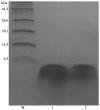Recombinant expression and biological characterization of the antimicrobial peptide fowlicidin-2 in Pichia pastoris
- PMID: 27698732
- PMCID: PMC5038210
- DOI: 10.3892/etm.2016.3578
Recombinant expression and biological characterization of the antimicrobial peptide fowlicidin-2 in Pichia pastoris
Abstract
Fowlicidins are a group of cathelicidin antimicrobial peptides that were initially identified in chickens. Fowlicidin-2, which is composed of 31 amino acids, is widely expressed in the majority of tissues in chickens and has an important role in innate immunity. In the present study, a recombinant expression system for fowlicidin-2 was successfully constructed using Pichia pastoris X-33 and the expression vector pPICZα-A. Under the optimized fermentation conditions, 85.6 mg fowlicidin-2 with >95% purity was obtained from 1 liter culture medium following purification by ion exchange chromatography and reversed phase high performance liquid chromatography. The recombinant fowlicidin-2 exhibited broad spectrum antimicrobial activity and had a minimum inhibitory concentration ranging from 1 to 4 µM. Furthermore, recombinant fowlicidin-2 exhibited hemolytic activity, promoting 50% human erythrocyte hemolysis in the concentration range of 128-256 µM, and anticancer activity, resulting in the death of 50% of A375 human malignant melanoma cells in the concentration range of 2-4 µM. The results of the present study suggest that recombinant fowlicidin-2 may be a promising candidate for therapeutic applications.
Keywords: Pichia pastoris; antibacterial activity; anticancer activity; antimicrobial peptides; fowlicidin-2; recombinant expression.
Figures






Similar articles
-
High-yield recombinant expression of the chicken antimicrobial peptide fowlicidin-2 in Escherichia coli.Biotechnol Prog. 2015 Mar-Apr;31(2):369-74. doi: 10.1002/btpr.2041. Epub 2015 Feb 2. Biotechnol Prog. 2015. PMID: 25641948
-
Expression of recombinant hybrid peptide cecropinA(1-8)-magainin2(1-12) in Pichia pastoris: purification and characterization.Protein Expr Purif. 2006 Dec;50(2):147-56. doi: 10.1016/j.pep.2006.05.023. Epub 2006 Jul 8. Protein Expr Purif. 2006. PMID: 16931049
-
Fowlicidin-3 is an alpha-helical cationic host defense peptide with potent antibacterial and lipopolysaccharide-neutralizing activities.FEBS J. 2007 Jan;274(2):418-28. doi: 10.1111/j.1742-4658.2006.05589.x. FEBS J. 2007. PMID: 17229147
-
The Central Hinge Link Truncation of the Antimicrobial Peptide Fowlicidin-3 Enhances Its Cell Selectivity without Antibacterial Activity Loss.Antimicrob Agents Chemother. 2016 Apr 22;60(5):2798-806. doi: 10.1128/AAC.02351-15. Print 2016 May. Antimicrob Agents Chemother. 2016. PMID: 26902768 Free PMC article.
-
Secretory expression of human protein in the Yeast Pichia pastoris by controlled fermentor culture.Recent Pat Biotechnol. 2010 Jun;4(2):153-66. doi: 10.2174/187220810791110679. Recent Pat Biotechnol. 2010. PMID: 20180764 Review.
Cited by
-
The dual interaction of antimicrobial peptides on bacteria and cancer cells; mechanism of action and therapeutic strategies of nanostructures.Microb Cell Fact. 2022 Jun 18;21(1):118. doi: 10.1186/s12934-022-01848-8. Microb Cell Fact. 2022. PMID: 35717207 Free PMC article. Review.
-
Heterologous Production of Antimicrobial Peptides: Notes to Consider.Protein J. 2024 Apr;43(2):129-158. doi: 10.1007/s10930-023-10174-w. Epub 2024 Jan 5. Protein J. 2024. PMID: 38180586
-
Antimicrobial Peptides: Recent Insights on Biotechnological Interventions and Future Perspectives.Protein Pept Lett. 2019;26(2):79-87. doi: 10.2174/0929866525666181026160852. Protein Pept Lett. 2019. PMID: 30370841 Free PMC article. Review.
-
Pichia pastoris: A highly successful expression system for optimal synthesis of heterologous proteins.J Cell Physiol. 2020 Sep;235(9):5867-5881. doi: 10.1002/jcp.29583. Epub 2020 Feb 14. J Cell Physiol. 2020. PMID: 32057111 Free PMC article. Review.
-
Revolutionizing orthopedic healthcare: a systematic review unveiling recombinant antimicrobial peptides.Front Microbiol. 2024 Apr 29;15:1370826. doi: 10.3389/fmicb.2024.1370826. eCollection 2024. Front Microbiol. 2024. PMID: 38756724 Free PMC article.
References
LinkOut - more resources
Full Text Sources
Other Literature Sources
